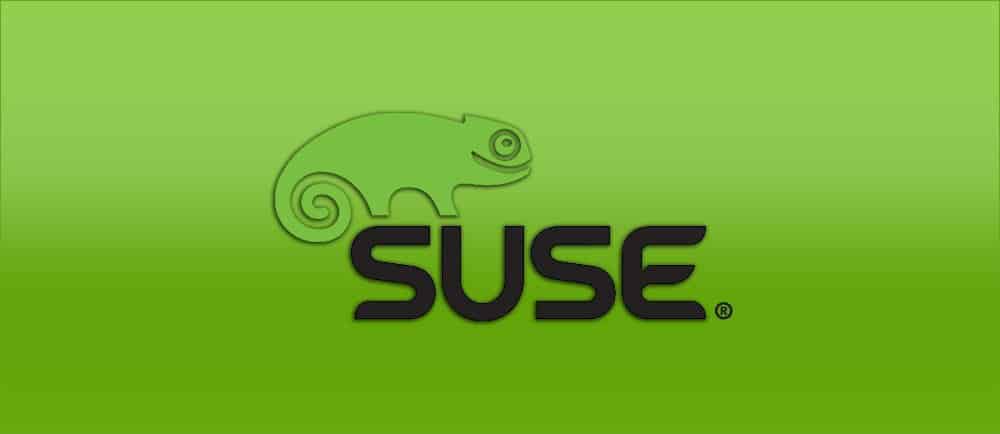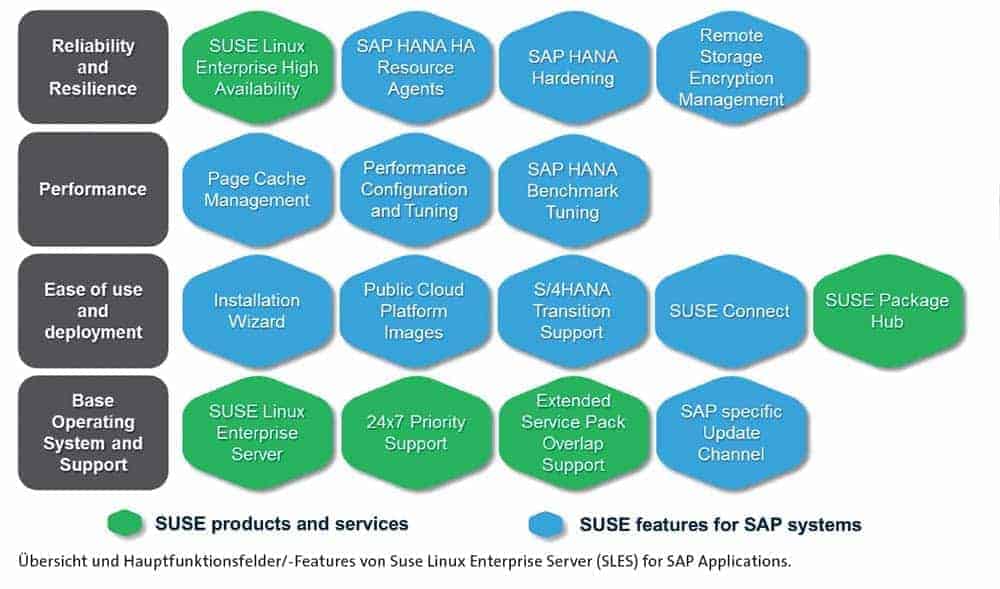Legal cornerstones


The switch to Hana and the use of Hana-based solutions such as S/4 as the "digital core" or the SAP Cloud Platform (SCP) including IoT are associated with a number of changes. One focus is the switch to Linux - and the use of other innovative open source solutions as future-proof infrastructure cornerstones for mission-critical SAP use in the age of digitization, which are provided by Suse and from which customers benefit.
All existing SAP Business Suite customers are now well aware that full Any DB support will come to an end in 2025. Thousands of companies around the globe are being urged to migrate their SAP systems to Hana and the ERP technology successor SAP S/4 Hana.
This entails a number of changes - both on the application side and on the SAP IT infrastructure side. Some of the users have already made these changes.
The fact is: On the one hand, this involves a change of database, from a so-called Any-DB such as Oracle, DB2 or MS SQL Server in the direction of the SAP in-memory database Hana.
At the same time, the SAP realignment means a change in the servers used (and possibly also in the storage systems). Here, SAP customers have the option of choosing from several hardware providers: here a large number of Intel x86-based Hana server systems, there Power processor-driven Hana servers from IBM, also for scale-out and scale-up use.
It is also necessary to make an operating system switch to Linux, the OS (operating system) specified by SAP for Hana database deployment or from Hana-based solutions such as S/4 or BW/4, the very solutions that require the Hana database.
This means that a very large number of existing SAP customers using Unix or Windows - according to surveys by market researchers such as IDC, around 50 percent of all business suite users still use Windows alone - have to switch to Linux.
Because the hardware of Unix-SAP users is not Linux-compatible, this user group has to deal with a triple migration, so to speak: Hardware, database and Linux migration. This applies in a similar way to Windows SAP users, since all x86 Hana server systems must have SAP certification, which is generally not the case with existing systems.
Platform expansion of SLES for SAP Applications
A significant number of SAP users already know Linux inside out from a wide variety of SAP Business Suite deployments and intensified SAP Hana or S/4 use.
Others - especially existing Unix and Windows SAP customers who are just starting the Hana switch - are not at all or not very familiar with it. The following explanations are aimed at both groups of SAP customers.
As an operating system platform selected and recommended by SAP, what does Suse Linux Enterprise Server (SLES) for SAP Applications do in interaction with SAP Hana or with Hana-based SAP solutions such as S/4 Hana?
Or: In addition to SLES for SAP Applications (in the current version 12), what solutions does the long-standing SAP partner and open source innovator Suse provide for SAP users that are geared towards using agile as well as flexible and, in particular, digitization-compliant IT infrastructures in the hybrid or multi-cloud and software-defined infrastructure (SDI) era in a beneficial way?
First of all, it is important to know that Suse and SAP can look back on a long and very successful partnership. Just as Suse, as an open source key player, has continuously expanded its very extensive partner network over the past 25 years.
Suse was involved in 1999 when SAP launched the Walldorf Linux Lab. The goal at that time was to develop an enterprise Linux for mission-critical SAP use. Actually, the topic of SAP Adaptive Computing was added only slightly later; specifically, to support Flexframe for SAP from Fujitsu.
Which Suse also put into practice - also with SLES for SAP Applications, today's market-leading Linux operating system platform in the SAP environment. And by the way, SLES for SAP Applications is still the only Linux operating system platform for the Flexframe solution (see also the Fujitsu article on pages 68 and 69).
Other highlights of the SAP-Suse collaboration over time: the availability of SLES for SAP Applications HAE (High Availability Extension), an Installation Wizzard for the semi-automated installation of SAP Basis components, SLES for SAP Applications as a standard for the SAP cloud solution Business By Design, the SAP BW Accelerator or as an operating system platform for SAP developments, and much more.
In 2009, Suse became involved in the then-secret "Project SAP Hana". The in-memory project changed SAP's DB strategy, and Suse's exclusivity on Intel for SAP Hana ran for a period of five years, and on IBM Power to this day.
It is obvious that SAP customers benefit from the immense experience and know-how advantage of now thousands of Hana SLES for SAP Applications installations.
Whereby the common togetherness is constantly expanding. For example, in connection with SAP Hana 2, a new Hana HA feature in the context of an active-active architecture in a clustered Hana environment with a focus on "Secondary Read Enabled" is a highlight based on Suse technology.
Right from the start of Hana, Suse Linux Enterprise Server for SAP Applications was much more than a standard operating system, responsible only for processing machine- or process-dependent commands.
As a platform, this variant also contains numerous features specially developed for SAP Hana use that go beyond the classic Suse SLES version and provide advantageous support for important data center functionalities in SAP use. They were developed in years of close cooperation or coordination with SAP.
This concerns RAS (Reliability and Resilience) aspects as well as performance, ease-of-use/deployment and basic operating or support topics. All with the aim of providing high-performance and innovative products and support services to help user companies reduce complexity, increase automation, reduce costs and provide reliable services for mission-critical SAP Hana deployment.
Special features developed for SAP Hana
For example, a number of features of SLES for SAP Applications ensure that the most extensive possible High Availability (HA), including DR functionality, is available for Hana deployment in accordance with the "Towards Zero Downtimes" approach, and that the increasingly important topic of RAS, including security, is covered.
For years, the Suse High Availability Extension (HAE), already included in SLES for SAP Applications, has been a proven and leading high availability solution, offering sophisticated features to improve business continuity/high availability as well as for disaster recovery support when using SAP.
The solution was optimized and further developed especially for SAP Hana use and also represents a kind of standard for HA and DR in the SAP Hana environment (for scale-out and scale-up). SAP provides SAP Hana System Replication (SR) mechanisms for HA in particular.
The Suse High Availability Solution (HAE) of SLES 12 for SAP Applications enables the SLAs to be increased via automation. System replication via a memory preload in a cluster (e.g., 2-node cluster) is generally preferred as the central HA solution for SAP Hana.
Automation of the switchover can be conveniently executed using Suse HAE; for example, in a 2-node cluster with a (second) synchronously running HA system for a Hana on-site system (would then be node one).
For a DR scenario, SAP Hana System Replication enables asynchronous replication to another site (for example, another data center), so that this covers the disaster case. Also integrated in Suse SLES 12 for SAP Applications, for example, is the technology developed by Suse called kGraft, a live kernel patching technology.
It enables online updating of security patches without rebooting or waiting for the next scheduled service window.
Hana Resource Agents
Also worth highlighting: SAP Hana Resource Agents (RA). These can be used to manage, monitor and control Hana database instances and replications. The RAs can also be configured. And:
Suse supports easy-to-use cluster configurations with the SAP Hana Resource Agents. They run on all nodes of a SLES 12 for SAP Applications HAE cluster and provide configuration information or system status of Hana systems and Hana replications (for system management purposes, for example).
In addition, it is possible to use overarching management systems such as Datavard Insights from SAP and Suse partner Datavard for monitoring and controlling or for proactive alerting of SAP Hana and SLES for SAP Applications. (See also the article on Datavard Insights on page 15).
Another example in connection with the SLES for SAP Applications RAS functionality provided is Security Hardening for Hana. Here, a high level of hardening of Suse SLES for SAP Applications counteracts attacks or threats from outside.
It can also be used to implement mechanisms that show which operating system packages should be available and which can be dispensed with. The core focus is that fewer packages mean a smaller attack surface against threats. Another function integrated into SLES 12 for SAP Applications is Remote Storage Encryption Management or a configurable firewall, which is supplied as standard.
In addition, version 12 provides so-called SAP Hana patterns for further simplification/automation of Hana installations for the Simplified Operations topic area, up to and including complete automation of SAP solution-based systems across entire IT landscapes in accordance with an n-tier approach. Numerous other features for mission-critical Hana deployment are already included in version 11 of SLES for SAP Applications.
All core functions/packages of the SLES for SAP Applications operating system platform for RAS, Performance, Ease of Use and Deployment (with Simplified Operations, for example, based on the Suse Manager management solution) and Base Operating System and Support can be found in the figure "Suse Linux Enterprise Server for SAP Applications: Overview of key function areas". It is obvious that Suse SLES for SAP Applications will be developed further on a quasi-permanent basis or that new technologies will be integrated. It is conceivable, for example, that the topic of machine learning will be included. For example, in the form of functions based on Google TensorFlow.
SLES for SAP Applications and beyond
The footprint or role of Suse in the SAP environment now extends far beyond SLES for SAP Applications. Particularly against the backdrop of the digital transformation and the solution innovations made available on an open source basis, which offer beneficial advantages as further infrastructure anchors or important cornerstones.
SAP Hana and S/4 Hana are supported as the digital core, including a new user experience based on Fiori. As is well known, the business suite technology successor takes into account both ERP use and the use of big data, analytics, mobile computing, business networks or SAP Leonardo with Internet of Things (IoT).
And that in on-premise and cloud operation, in hybrid form on-premise/cloud or in the form of multi-cloud use. (See also the QSC article on pages 61 and 62).
Suse Linux Enterprise Server for SAP can be used everywhere in conjunction with Hana or Hana-based solutions - as one infrastructure for all deployment forms, so to speak: on Hana-on-Intel-x86, on IBM Hana on Power, but also via Amazon AWS, the Google Cloud Platform (GCP), the SAP Cloud Platform and the SAP Hana Enterprise Platform (HEC) or via Microsoft Azure. This is very much in line with standardization, especially in view of the increasing multi-cloud use.
The digital transformation also brings new requirements for applications, application development and data center operations, based on the DevOps model. Here, application development and IT operations are intelligently interwoven according to requirements in order to make new applications available quickly or on demand in a timely manner.
Incidentally, with SAP Core Data Services, Hana and S/4 are moving even closer together, which supports the DevOps idea. An important factor here is the need for a dynamic and highly flexible IT infrastructure and components based on software-defined data center (SDDC) or software-defined infrastructure principles.
In this context, as mentioned above, Linux plays an important role as an open source operating system platform for Hana. But the focus is also on Hadoop, for example, as a component for Big Data.
On top of that, the core elements OpenStack (IaaS) for cloud server provisioning, Cloud Foundry (PaaS) as a development platform or Container-as-s-Service (CaaS) including Kubernetes Magnum or Docker for efficient virtualization use. All of which, by the way, are very significant infrastructure elements or components of the SAP Cloud Platform, a linchpin for app development and deployment when using S/4 Hana.
OpenStack, Cloud Foundry and SCP
A look at OpenStack, Cloud Foundry and Container-as-s-Service: Like the OpenStack Foundation, the Cloud Foundry Foundation is a free, open-source project supported by many well-known companies across vendors as a non-profit organization.
SAP and Suse are among them, but also many, many others from the IT and non-IT environment, such as General Electric. As the first Linux distributor ever, Suse has been a member of the OpenStack Foundation since 2012 and introduced the first enterprise OpenStack solution, Suse OpenStack Cloud, in the same year. Suse has been a Cloud Foundation member since 2015.
With Cloud Foundry and the Cloud Foundry components, the Foundation delivers concretely deployable software solutions. The OpenStack counterpart also certifies the various PaaS solutions of the Cloud Foundry members. In particular, this ensures that cloud platforms are compatible and consistent with each other on the basis of a uniform and open standard.
The focus of the Suse-SAP activities (SAP-Suse-Co-Development) is the provision of an OpenStack Cloud Provider Interface (CPI). The main focus here is to use a CPI to simplify or automate communication between Cloud Foundry and the underlying OpenStack infrastructure.
This enables low-cost testing of application apps and their immediate rollout and deployment in private or public clouds. The SAP Cloud Platform (formerly Hana Cloud Platform, HCP) makes use of the above.
By using an open source OpenStack-based IaaS cloud (private or on-premise) for SAP applications, there are tangible benefits - up to and including the fact that SAP solutions can be rolled out efficiently and cost-effectively.
In the course of digitalization, services or applications can be provided quickly and flexibly. More and more companies, but also IT service providers, are relying on OpenStack-based cloud environments.
The current release of Suse OpenStack Cloud is currently available in version 7 and already includes Container-as-a-Service functionalities. In addition, it enables software upgrades that no longer involve any disruption to ongoing operations.
For example, this release already offers full support for Docker based on Kubernetes as the framework for container orchestration provided as part of the OpenStack Magnum integration. This gives customers access to container-as-a-service capabilities that enable them to develop innovative cloud-native workloads and applications, as well as support DevOps processes and environments.
There are also additional high availability features, including high availability protection for virtual machines and workloads, which complement the high availability for control planes and compute nodes. Customers can thus also move business-critical applications to the cloud.
Also available is an integration of OpenStack Manila with CephFS, delivered via Suse Enterprise Storage. This provides a unified storage environment that allows customers to run workloads for their block, object, and file storage systems in a single cluster to reduce capital and operational costs.
Users also get improved scalability that allows deployment across multiple data centers. Users, incidentally, are thus able to administer multiple private clouds from a single user interface.
Cloud Foundry Dojo at SAP Cloud Lab
As is well known, PaaS as a cloud service is based on IaaS. Suse and SAP are focusing on the integration of OpenStack and Cloud Foundry outlined above with the so-called Cloud Foundry Dojo, SAP Cloud Lab. In doing so, Suse and SAP continue to push joint developments in both Linux and OpenStack and Cloud Foundry integration.
An advantage here is that Suse technology assets in the OpenStack and Cloud Foundry area are expanding through the acquisitions of HPE assets. Some of these have already been integrated into the Suse portfolio. Suse underpins the topic of Container-as-a-Service (CaaS) with the new Suse CaaS Platform.
The focus here: flexible, simplified and automated options for delivering small-scale services (microservices) with the help of containers - including the use of Docker or Kubernetes. Kubernetes in particular is able to efficiently support container apps in cluster environments (physical or virtual machines).
Likewise, Kubernetes is preferred in order to advantageously put the goal of a container-centric infrastructure into practice (instead of a rather rigid host-centric one). In this context, Suse Linux Enterprise Server (SLES) also plays a role as a container host OS in a specialized version (SLES Micro OS). The benefit here: a small footprint with optimal resource utilization.
DevOps and Open Source
The use of DevOps (Development and IT Operations) with the SAP Cloud Platform using open source solutions is already state of the art today for developing and managing applications - including complete and full life cycle management. This virtually paves the way for SAP user companies to implement and operate new apps in accordance with business requirements.








